The Intel Broadwell Xeon E3 v4 Review: 95W, 65W and 35W with eDRAM
by Ian Cutress on August 26, 2015 9:00 AM ESTIntel Broadwell Xeon E3 v4 Conclusions
If you skipped to the end without looking at the benchmark data, we’re going to throw a few graphs in here for good measure.
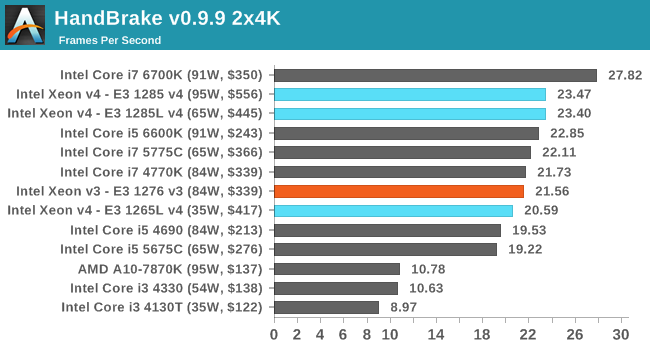
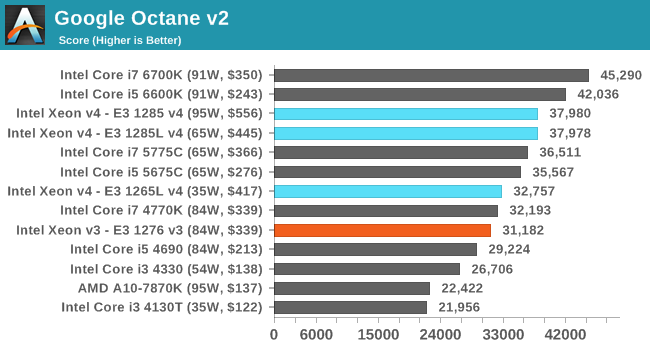
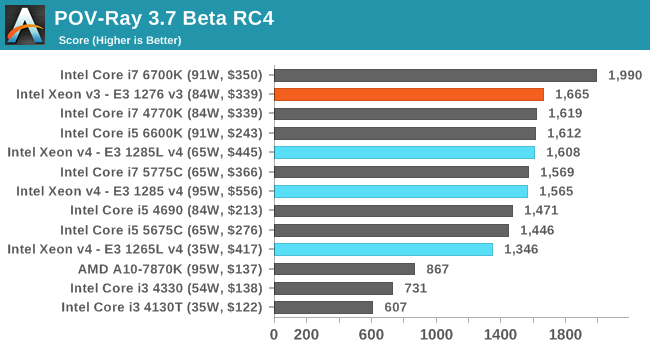
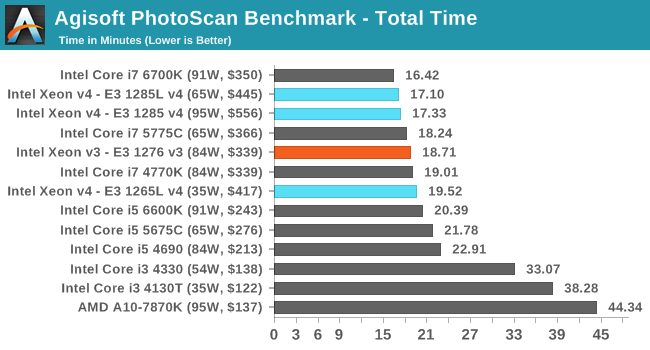
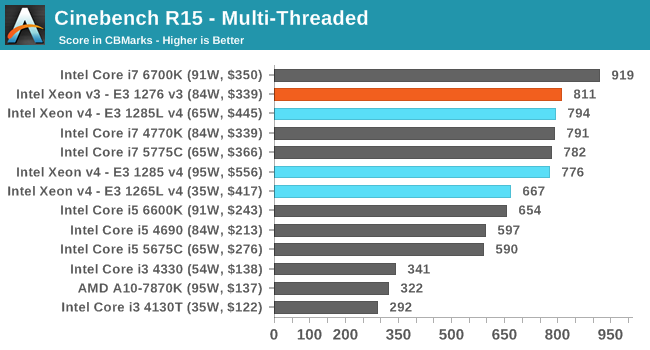
We said at the start of this review that one of the key parts to examine was the main parallel to the 95W of the E3-1285 v4 and the E3-1276 v3 at 84W due to their near similar (but not ideal) thermal design power metrics. The differentiator here is that the E3 v3 has some extra frequency, but the E3 v4 range has eDRAM.
At least, we thought this should be the battle to be had, but it is clear from the results that something else is more interesting. Comparing the E3-1285 v4 at 95W to its lower power variant, the E3-1285L v4 at 65W, we see that the low power variant scores better on almost all benchmarks.
The only difference between these two processors aside from the 30W of TDP should be the 100 MHz gap in favor of the 95W part. We said at the beginning that this 100 MHz does not adequately explain 30W in the grand scheme of things, so the lower powered model must also have a substantially better voltage/frequency profile. This, as it happens, has some knock on side effects.
In a couple of CPU tests, the extra frequency wins. This boils down to only 3DPM and Sunspider, both tests that arguably are neither extensively pressing the processor nor exhaustive in their capabilities. But the lower power model, by virtue of the better binning, is able to keep its higher frequency turbo mode available for 100% of the time in our testing, ultimately giving a higher frequency and completing work quicker. This is despite the base frequency of the E3-1285 v4 being higher, and alluding to a variable turbo frequency profile based on power draw. To cap it off, the E3-1285L v4 is also $111 cheaper. So when the two processors are put side-by-side, the decision is obvious. We would choose the E3-1285L v4 every time.
This means the title fight should be between the 65W E3-1285L v4 and the E3-1276 v3 at 84W. Here it gets a little more edgy – the v4 here is technically 100 MHz above the i7-5775C which we looked at in our last Broadwell review, and we get more into a performance/power based efficiency discussion based on the TDP difference than the 95W vs 84W discussion.
In DRAM heavy scenarios such as WinRAR, which requires a large amount of cache to retain dictionary compression tables, the benefits of the eDRAM are easy to see. Benchmarks on the integrated graphics also win out due to the Iris Pro P6300. For discrete graphics, the Broadwell parts certain win over the v3 for efficiency at this point, with results between the two being almost identical. But the big one to note here is Photoscan in pure CPU mode, where Broadwell takes a minor lead – Photoscan uses a set of fifty two-dimensional photos with no depth information to create a three-dimensional imagine over several stages, so managing that data around the memory subsystem becomes a handful when there are 40,000 data points per picture in flight. This benchmark was suggested to us by an archivist at a national library who uses it to recreate models of the artifacts in their storage for external examination.
For all the other CPU tests, a dichotomy appears. The higher frequency v3 wins for compute driven performance, but data driven metrics (and efficiency) are the realm of Broadwell, Xeon or otherwise, as long as there is frequency to match.
As mentioned on the first page of the review, on the suggestion of a number of our readers and based on these interesting, we are looking into other avenues which are also data driven. Previously our Chrome compilation benchmark was a featured set piece in our testing, but has fallen away and a similar equivalent needs to be reintroduced. As a result, we are speaking to some users and looking into a series of tests of this nature that afford a repeatable and consistent point of analysis – ideally in an automated context if possible and encompassing a variety of projects and languages. At current there is no time framework for introduction, but September affords some time to focus on the project and then test a number of processors on it. Thoughts and suggestions should be forwarded to ian@anandtech.com.


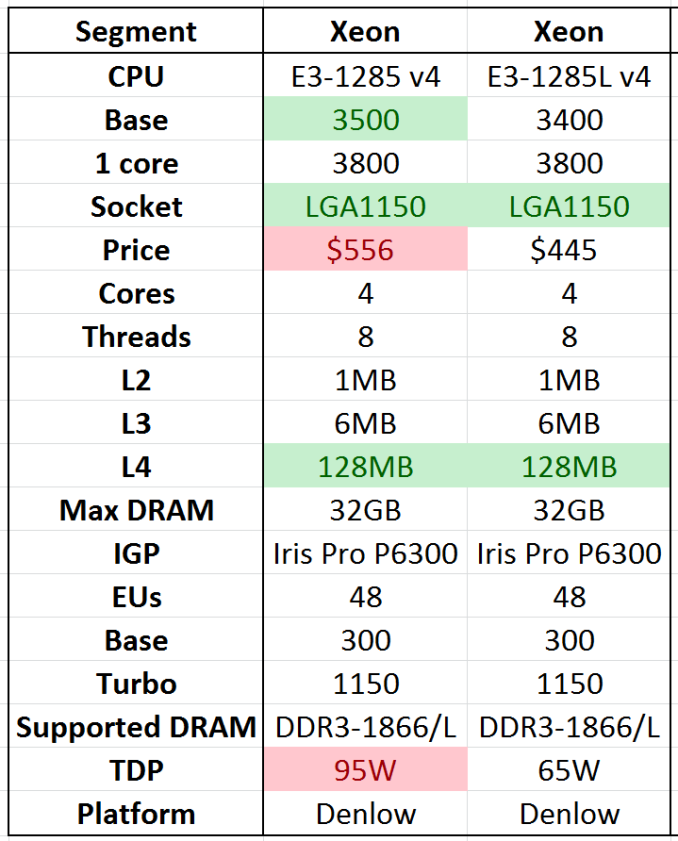
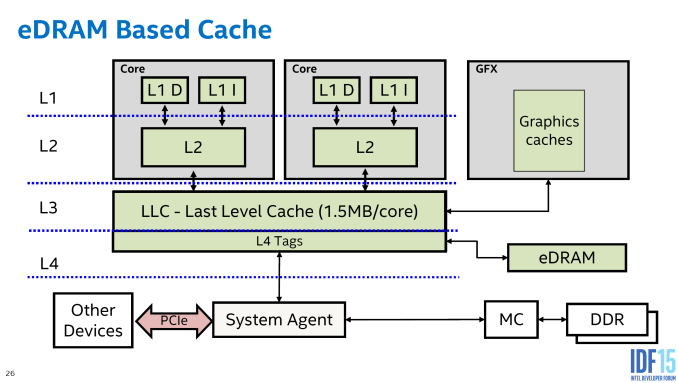








72 Comments
View All Comments
piasabird - Wednesday, August 26, 2015 - link
At $446 this isn't exactly an entry level CPU. I wonder where are the desktop CPU's with IRIS graphics like the i5-5575r which is suppose to be priced at $244 and available now but is not for sale anywhere?piasabird - Wednesday, August 26, 2015 - link
I guess Intel makes this processor but would rather have you buy a more expensive one. What is up with this? Same thing goes for i5-5675cdgingeri - Wednesday, August 26, 2015 - link
It's not meant to be a cheap CPU. It's a workstation/server chip. I has some additional data integrity features that the normal desktop CPUs can't use, like ECC memory. The drivers for the GPU are also optimized and tested for workstation level software, which is expensive to do. Sometimes, just frequency isn't enough.Camikazi - Friday, August 28, 2015 - link
I always wonder how people don't see that a server part is going to be more expensive than a desktop part. They always have been and always will be because they are binned higher and have additional features that desktops don't or can't use. Saying that $446 for this CPU is actually rather cheap for an entry level Xeon CPU and is not a bad price.Free008 - Tuesday, September 1, 2015 - link
Thats right it's too expensive. Intel will continue to gouge consumers with lower quality binned parts and disabled server features until Apple starts making decent desktop CPUs and then we can forever leave Intel and Microsoft at our leisure. Thats why none of the mobile Intel CPUs are selling - most the suppliers dont want to go back to the old monopoly days regardless of performance (which isn't incrementally significantly anymore anyway, just power savings). Intel thinks suppliers and consumers will put up with this forever but they are so wrong. It's just a matter of time now.zoxo - Wednesday, August 26, 2015 - link
It is rather disappointing that it seems that energy efficiency has regressed since the awesome 4790K. I was hoping that switching to 14nm would allow intel to do what the 88W 4790K could do in the 65W power envelope, but neither broadwell or skylake seems to be able to deliver that promise.mmrezaie - Wednesday, August 26, 2015 - link
I am also wondering why even though the performance is not changing that much but why power usage is not getting that much better!milkod2001 - Wednesday, August 26, 2015 - link
While CPU performance of the chip is only a little bit better, its GPU part is much bigger and performs much better, hence power consumption is the same as older chips. It's actually an achievement.For regular desktop CPUs i'd prefer Intel to give us native mainstream 6 core with no GPU at all.
But that would not played nicely with premium E series CPU. Money, money, money. Give me more :)
zoxo - Wednesday, August 26, 2015 - link
If you consider pure CPU loads, broadwell/skylake doesn't seem to show much power advantage over devil's canyon when you are getting to the 4GHz range. Skylake seems to be more overclock friendly, but it does consume a lot of power doing it.azazel1024 - Friday, August 28, 2015 - link
I was thinking the same thing based on Anandtech's original tests, but if you look at their notes under the delta power consumption and looking at a few other review sites, it looks a lot like motherboard manufacturers are all over the board with voltage/frequency curves for Skylake (and I assume here with Broadwell too) and it is biting them in the butt on power consumption. You've got a difference of easily 35% in power consumption from one board to the next using the same chip.Using the better numbers I have seen in some tests, Skylake, specifically the 6700k is actually significantly better than any other generation in performance per watt. Looking at the higher numbers in a few reviews, it is much worse than Broadwell and Haswell and only fractionally better than Ivy Bridge. I suspect that Skylake and probably Broadwell, that Intel's 14nm process has poor voltage/frequency scaling. Also that most motherboard manufactures are choosing poor voltage curves for the chip in an attempt to be extremely conservative.
A knock on effect here is, it is likely to be impacting actual performance too. If the 6700k has a TDP of 94w and the Dp is 110w...I'd half imagine that there is some throttling going on there with some loads.